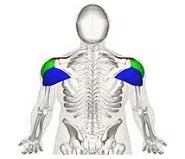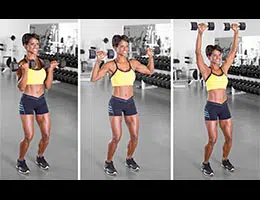 The word deltoid comes from the Greek letter delta . The term is used as an adjective to describe something whose shape is reminiscent of a capital delta . The most common use, however, is linked specifically to a muscle .
The word deltoid comes from the Greek letter delta . The term is used as an adjective to describe something whose shape is reminiscent of a capital delta . The most common use, however, is linked specifically to a muscle .
The deltoid is a triangular muscle that is part of the anatomy of mammalian animals . In the case of humans , the deltoid extends between the clavicle and the shoulder blade, covering the joint of this bone with the humerus.
Innervated by the axillary nerve and with blood supply from the posterior circumflex artery, the deltoid is divided into three portions : the posterior portion, the middle portion, and the anterior portion. In the muscle , on the other hand, the deep face, the superficial face, the vertex, the anterior edge and the posterior edge can be recognized.
The posterior fiber of the deltoid inserts into the spine of the scapula, becoming involved in the movement of the arm when it is raised backwards. The anterior fiber , inserted into the clavicle, contributes to the elevation of the arm forward. As for the acromial fiber , its function is to allow the separation of the shoulder.
Those who want to train the deltoid muscle must do different activities to exercise the three types of fibers that make it up. Although the muscle can be strengthened to improve the stability of the joint and resist greater efforts, it is important to also exercise the rest of the muscles in the area to avoid imbalances. The shoulder is unstable and the strengthening of the deltoid over the other muscles can cause injuries .
Very often, people who are interested in improving their fitness do not pay attention to their shoulders, but focus mainly on developing their abs and arms. The problem is that strengthening the deltoids is essential to achieve the perfect finish, and for this it is necessary to have an adequate shoulder routine. As mentioned in a previous paragraph, this muscle is divided into three portions, also called heads , and the secret to a good workout is to work them all.
Before starting to learn and practice shoulder exercises, it is recommended to look for images of the deltoid in books or on the Internet to identify each of the three heads and locate them in our body . In this way, as we develop them with practice we will be able to verify their progress by touching these areas with our hands.
Below we will see two of the most recommended exercises, which are based on isolating the deltoids, although it is inevitable to also use the triceps . The first is known as the Arnold dumbbell press , and is named after Arnold Schwarzenegger , its creator. It is a variation of the traditional shoulder press , and offers a rotation movement throughout the range, forcing all three heads to work.
The Arnold press is made up of the following steps:
 * sit on a bench with back support and leave the weights on both sides;
* sit on a bench with back support and leave the weights on both sides;
* pick up the weights slowly and bring them to chin level, leaving your palms facing your torso;
* raise them slowly, without moving the dumbbells away from the torso;
* rotate your hands as you make an arc movement overhead to lift the weights.
The second of the exercises to define the deltoids is called the behind-the-neck press , and bodybuilding veterans love it, as it is ideal for widening the shoulders. We must begin by placing the bar at the ideal height for our body, and then:
* grab the bar from both sides to lift it using leg strength;
* slowly, separate your legs until they are aligned with your shoulders;
* exhale and raise the bar above your head until your arms are fully extended;
* maintain the position for a maximum of two seconds, inhale and return to the initial position.
